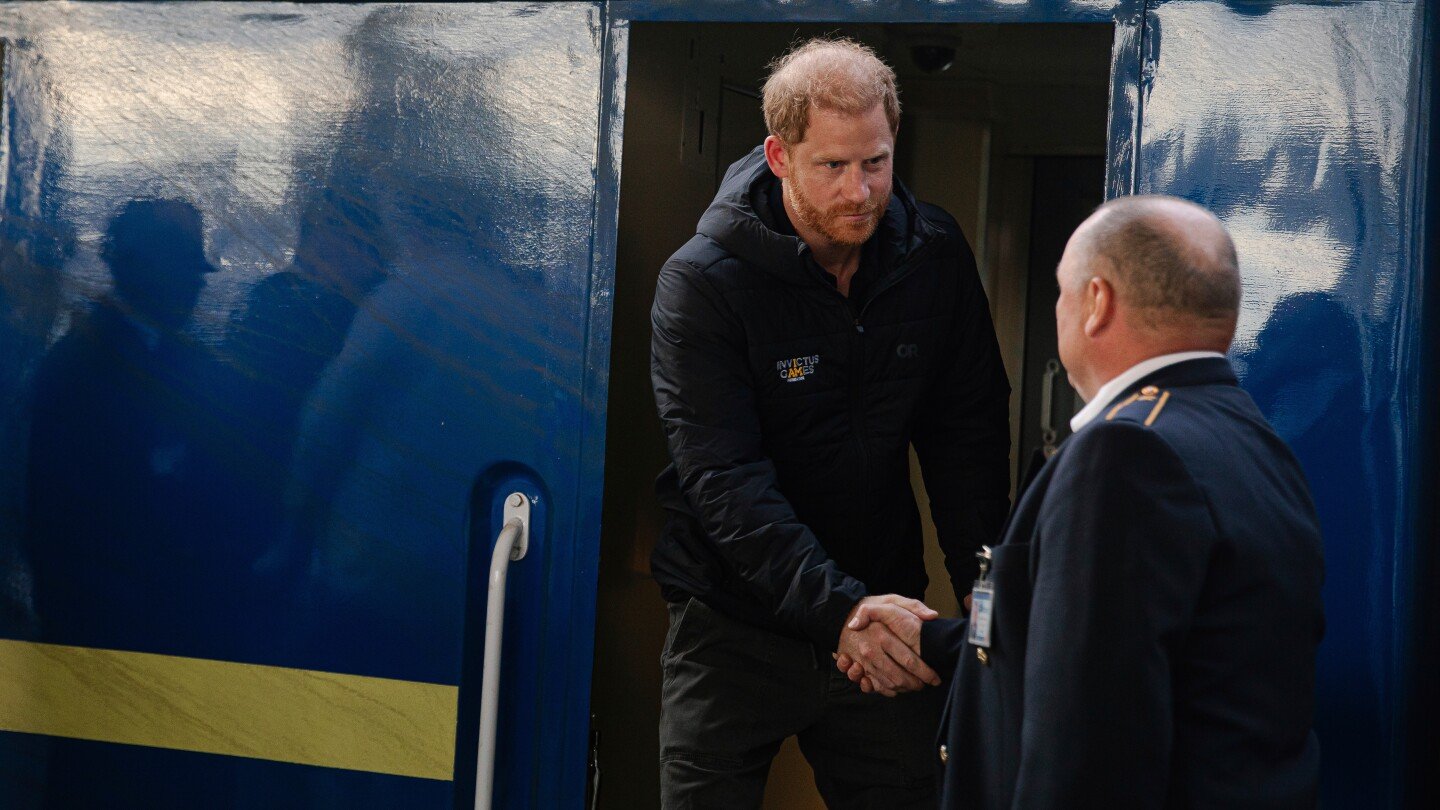Robbie in the Giorgio Armani Privé couture gown with silver Aquazzura heels.
(Photo by Tristan Fewings/Getty Images)

NEW YORK (AP) — Carlos Alcaraz reasserted his superiority over Jannik Sinner with a 6-2, 3-6, 6-1, 6-4 victory Sunday in the U.S. Open final for his second trophy at Flushing Meadows and sixth overall at a major. This was the third Grand Slam tournament in a row where these elite, young rivals met to decide the champion.
The match’s start was delayed for about a half-hour while thousands of fans were stuck outside Arthur Ashe Stadium while going through extra security because President Donald Trump sat in a sponsor’s suite. Perhaps the extra wait got the No. 1-seeded Sinner, who was the defending champion.
Right from the beginning, under a closed roof because of rain earlier in the day, No. 2 Alcaraz outplayed Sinner, reversing the result from when they played for Wimbledon’s title less than two months ago.
Alcaraz’s leads over Sinner are now 10-5 in their head-to-head series, 6-4 in major trophies, and 2-1 in U.S. Open championships. Plus, this 2-hour, 42-minute win allowed Alcaraz, a 22-year-old from Spain, to take away the No. 1 ranking from Sinner, a 24-year-old from Italy.
This hard-court matchup followed Alcaraz’s victory over Sinner after erasing a trio of match points on the French Open’s red clay in June, and Sinner’s victory over Alcaraz on Wimbledon’s grass in July.
“I’m seeing you more than my family,” Alcaraz joked, eliciting a grin from Sinner. “It’s great to share the court, to share the locker rooms, everything.”
Sunday’s showdown represented the first time in tennis history that the same two men played each other in three consecutive Slam finals within a single season.
“You were better than me,” Sinner told Alcaraz. “I tried my best today. I couldn’t do more.”
Truth is, these two guys are so, so much better than the rest of men’s tennis at the moment. Their traits are unique, their strengths multiple, their games untouchable at the moment.
Except, of course, against the other.
They have combined to collect the past eight Slam trophies, and 10 of 13. Novak Djokovic, whom Alcaraz eliminated on Friday, took the other three in that span.
Both Sinner, who had won his past 27 hard-court matches at majors, and Alcaraz offered glimpses of why they are so good, although it was rare that both were at their best simultaneously.
Alcaraz, who ended up with twice as many winners, 42-21, was superb in the first, third and fourth sets; Sinner’s top efforts arrived in the second.
Since the start of the 2024 U.S. Open, Sinner had won 33 of 34 matches at the majors; Sunday was his fifth straight final at those events. The loss? To Alcaraz at Roland-Garros.
Indeed, over the last two seasons, Sinner is now 1-7 against Alcaraz — and 109-4 against everyone else.
Alcaraz, meanwhile, has won 37 of 38 contests since May. The loss? To Sinner at the All England Club, Alcaraz’s lone defeat in a Slam final.
In 2025, Alcaraz now has more titles (a tour-leading seven) than losses (his record is 61-6, also the best in men’s tennis).
During his defeat at Wimbledon, Alcaraz was caught by a camera telling his team in Spanish: “From the back of the court, he’s much better than me.”
Perhaps that’s why Alcaraz was aggressive Sunday with his sledgehammer of a forehand — and on-target, too. Whenever even the smallest opening presented itself, Alcaraz tried to barge on through with that shot, going big early in points, which worked, either for an outright winner or forcing mistakes from Sinner.
Sinner had dropped a total of just one service game in his three matches leading into the final, but he did deal with an abdominal muscle issue in his semifinal. Sinner and one of his coaches said it was nothing serious, which might be right, but Alcaraz broke right away Sunday and five times in all.
To counteract the forehand effectiveness, Sinner made a tactical switch, going increasingly after Alcaraz’s backhand when possible.
Paid off. Briefly.
In the first set and third set, Alcaraz’s ratios were 11 winners to two unforced errors. Truly remarkable. In the second, those numbers swung the other way: five winners, 11 unforced errors.
An hour and 20 minutes in, it was a set apiece, after Alcaraz ceded one for the first time all tournament, allowing Neale Fraser to retain his distinction as the most recent man to win every set he played at the event — in 1960.
As Sinner worked his way into things, he would celebrate points by pumping a fist toward the box where his coaches and others, including Olympic champion ski racer Lindsey Vonn, were seated.
Ah, but it was Alcaraz who seemed to have more ticket-buyers on his side.
They regaled him with standing ovations. For one particularly magical volley at a hard-to-believe angle struck just before the ball hit the court — even Alcaraz himself liked that one, saying “Wow!” and breaking into a wide grin. For one special overhead smash to a corner with the tailing movement of a firefly.
And so on.
Sinner, needless to say, wasn’t as pleased by those sorts of strokes.
He bounced his racket off the ground and caught it after one lost point. He exhaled and shook his head after another.
Sinner simply doesn’t see that sort of stuff from anyone else.
___
Howard Fendrich has been the AP’s tennis writer since 2002. Find his stories here: https://apnews.com/author/howard-fendrich. More AP tennis: https://apnews.com/hub/tennis

Some 154 million people get health insurance through their employer — and many could see their paycheck deductions surge next year. Some will likely also see co-pays and other out-of-pocket costs rise.
Jeff Chiu/AP
hide caption
toggle caption
Jeff Chiu/AP
The United States has the most expensive health care in the developed world. Now it’s about to get even more expensive.
Some 154 million people get health insurance through their employer — and many could see their paycheck deductions surge next year, by 6% to 7% on average. Some will likely also see their out-of-pocket costs rise as employers pass along the spiking costs of care.
That’s because employers will be paying a lot more — almost 9% more per employee on average, for the same level of coverage — to provide health benefits for their workers. Even after cutting or changing their health care benefits, employers are facing the biggest price increase in 15 years, according to a new survey of more than 1,700 organizations by Mercer, a benefits consultancy.
And 59% of those employers told Mercer they plan to pass those higher prices along to their workers in the form of “cost-cutting changes,” such as higher deductibles, copays or other out-of-pocket costs, such as prices for filling prescriptions.
“It’s almost a perfect storm that’s hitting employers right now,” says Larry Levitt, executive vice president for health policy at KFF, a health policy research nonprofit.
“The price of health care is going up faster than it has in a long time,” he adds. “And typically when an employer is getting a big increase from an insurer, the employer is turning around and trying to pass on some or all of that to its workers.”
The surging health benefit costs come at a time when consumers are still feeling the hangover of pandemic-era record inflation and are generally uneasy about the U.S. economy. Though inflation has cooled considerably in the past two years, prices are starting to tick up again, as many of President Trump’s sweeping taxes on imports go into effect.
These soaring costs also underline a hidden-in-plain-sight truth about the broken U.S. health care system: For the majority of Americans under age 65, their employers ultimately decide how much they pay for health insurance and medical care.
Employers themselves are at the mercy of entities that have even more market power: Drug companies, pharmacy benefit managers, hospitals and others have collectively driven up the costs of accessing medical care in the United States. Health insurers, some owned by gigantic for-profit conglomerates, often draw the blame for the high costs of U.S. health care — as demonstrated by the national outpouring of rage and frustration against UnitedHealth Group, one of the world’s largest companies, after the head of its health insurance business was shot and killed last December.
But when it comes down to determining how much most working Americans pay to stay healthy, the buck stops with employers. And now they’re planning on charging a lot more.
“It’s kind of hidden, because [premium deductions are] coming out of your paycheck and if you’re not paying close attention, it may not be obvious,” Levitt says. “But your take-home pay is going down.”
Some of the reasons for the rise in health care prices are actually good news. For example, pharmaceutical companies have developed more effective cancer treatments and weight-loss drugs — which they can also charge more for. And after several years when the COVID-19 pandemic and soaring inflation made many people reluctant to seek non-urgent care, more people are going to the doctor or other providers. But that surge in demand has also led to a surge in prices.
Other reasons have to do with a loss of competition. Some hospitals, doctors’ offices, insurance companies and other businesses within the health care system have merged or consolidated, often allowing the remaining businesses to raise prices for their services.
“What’s missing in health care is: It’s not a traditional free market. You don’t have those competitive forces,” says Sunit Patel, Mercer’s chief actuary for health and benefits in the United States.
This isn’t the first time employers are facing this problem: The costs they pay to provide health care are steep, and those have been rising for years.
Last year, the average U.S. employer spent more than $19,000 per employee to provide family coverage while the employee kicked in $6,000, according to KFF. The total average family premium of $25,572 has increased 52% in the past decade.
Beth Umland, Mercer’s director of health and benefits research, says that employers have tried to avoid passing on all the recent cost increases to employees, in part to try to retain workers during a tight post-pandemic labor market. But after years of elevated costs, she says, “I think just something had to give.”
Employers tend to consider health care benefits as part of the total compensation they pay workers — meaning that if they are spending more on health care, they will probably spend less on traditional salary increases.
And while workers have tried-and-true methods of asking for salary raises, they generally have less opportunity to bargain over the prices their employers set for health care.
“In general for workers, it’s kind of take it or leave it,” Levitt says. “And they really don’t have much of a choice but to take it.”

LONDON (AP) — Britain’s Prince Harry has arrived in Ukraine for a surprise visit in support of wounded service members.
Harry’s representatives confirmed they were in the capital, Kyiv, on Friday, though they declined to discuss the prince’s schedule for security reasons.
This is the second time Harry has visited Ukraine since the start of Russia’s full scale invasion in 2022. He made a trip to the western city of Lviv in April.
“We cannot stop the war but what we can do is do everything we can to help the recovery process,” Harry told the Guardian newspaper while on an overnight train to Kyiv.
Harry, a British Army veteran who served in Afghanistan, is the founder of the Invictus Games, a Paralympic-style event designed to inspire military veterans around the world as they work to overcome battlefield injuries. Ukraine is bidding to host the games in 2029.
The Archewell foundation set up by Harry and his wife Meghan announced this week that it had donated $500,000 to projects supporting injured children from Gaza and Ukraine. The money will be used to help the World Health Organization with medical evacuations and to fund work developing prosthetics for seriously injured young people.
The Guardian said that Harry will visit the National Museum of the History of Ukraine in the Second World War, spend time with 200 veterans and meet Ukrainian Prime Minister Yulia Svyrydenko.
His visit coincided with a trip to Ukraine by British Foreign Secretary Yvette Cooper, who announced a new set of U.K. sanctions targeting Russia’s oil revenues and military supplies.
Cooper said the visit is a show of solidarity with Ukrainians facing intensified assault from Russia – including 6,500 drones and missiles in July, 10 times the level of a year ago.
Harry’s appearance in Ukraine follows a four-day trip to the U.K., where he met his father, King Charles III, for the first time in 19 months. The meeting was seen as a first step in repairing frigid relations between Harry and other members of the royal family, which deteriorated after he and his wife, the former Meghan Markle, gave up royal duties and moved to California in 2020.
Harry and his father last met in February 2024, when the prince flew to London after receiving news that Charles had been diagnosed with cancer. Harry spent about 45 minutes with Charles before the king flew to his Sandringham country estate to recuperate from his treatment.
Prince Harry’s last trip to Ukraine included a visit to the Superhumans Center, an orthopedic clinic in Lviv that treats wounded military personnel and civilians. The center provides prosthetic limbs, reconstructive surgery and psychological help free of charge.
Harry’s visit Friday come as Russia escalates its war against Ukraine.
It is less than a week after Russia’s largest aerial attack on Ukraine since its all-out invasion began more than three years ago — an attack in which the main Ukrainian government building was hit. It also comes just days after numerous Russian drones entered the airspace of NATO member Poland — the country Harry traveled through to reach Ukraine.

The red carpet overheated on Thursday as two A-listers stripped down to reveal the latest additions to the sheer dressing boom.
Naked ensembles are ubiquitous these days but Margot Robbie and Dakota Johnson upped the ante with their takes at separate events. First, the Barbie star and producer (and new mother) stepped out at the London premiere of her new film, A Big Bold Beautiful Journey, in a sheer dress from Giorgio Armani Privé’s spring 2025 couture collection. The showing comes just days after Armani died at age 91, making the appearance a sweet (and spicy) tribute to the beloved designer.
Robbie’s gown featured a sheer base with beadwork in the shape of floral and paisley designs spread across it. The show-stopping moment came when Robbie turned around to reveal that the spaghetti straps of the dress crossed to accentuate a jewel-shaped pendant on her back, while down below, the gown did little to cover her bare backside.
Robbie in the Giorgio Armani Privé couture gown with silver Aquazzura heels.
(Photo by Tristan Fewings/Getty Images)

Robbie’s barely-there ensemble.
(Photo by Tristan Fewings/Getty Images)

Colin Farrell and Robbie. The actor stepped out in a look by Dolce & Gabbana featuring a double-breasted cotton trench coat over a martini-fit button-down shirt paired with wool pants. He accessorized with a satin tie and patent leather derby shoes.
(Photo by Joe Maher/Getty Images)
Meanwhile, in New York, Johnson, who just starred in back-to-back films Splitsville and Materialists, attended Kering’s Caring for Women gala in a black barely-there number by Gucci styled by Kate Young. The sheer base, embroidered with a floral design and featuring a high neck and train, revealed a matching bra and panties set. The gala proved to be a star-studded affair, attended by the likes of Demi Moore, Jessica Chastain, Julianne Moore, Salma Hayek, Lauren Sanchez Bezos, Adrien Brody, Casey Wasserman and more. Also notable: Anna Wintour turned up and posed on the red carpet with her Vogue replacement, Chloe Malle, the newly-installed Vanity Fair editor-in-chief Mark Guiducci and good friend Baz Luhrmann.
See closer looks at the sheer ensembles below.

Johnson’s cheeky ensemble.
(Photo by Mike Coppola/Getty Images)

Johnson accessorized the look with a diamond necklace and emerald drop earrings.
(Photo by Mike Coppola/Getty Images)

Johnson in full view.
(Photo by Mike Coppola/Getty Images)

One last look for the road.
(Photo by Joe Maher/Getty Images)


The Guardian view on Trump and the Fed: independence is no substitute for accountability | Editorial
Building Trust in Military AI Starts with Opening the Black Box – War on the Rocks


SDAIA Supports Saudi Arabia’s Leadership in Shaping Global AI Ethics, Policy, and Research – وكالة الأنباء السعودية


Journey to 1000 models: Scaling Instagram’s recommendation system


Mumbai-based Perplexity Alternative Has 60k+ Users Without Funding


Happy 4th of July! 🎆 Made with Veo 3 in Gemini


VEX Robotics launches AI-powered classroom robotics system


Macron says UK and France have duty to tackle illegal migration ‘with humanity, solidarity and firmness’ – UK politics live | Politics


Kayak and Expedia race to build AI travel agents that turn social posts into itineraries


OpenAI 🤝 @teamganassi